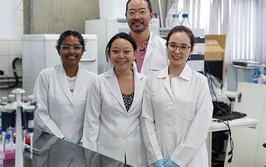Share, and We All Grow Richer
Free and open-source scientific hardware has the potential to liberate collective intelligence and cut costs

“The miracle is this: the more we share, the more we have.” Star Trek’s Leonard Nimoy summarizes beautifully here a concept that is already well known by real scientists. We are all accustomed to benefiting from the literature, where our past and present colleagues openly share both their genius and more modest good ideas. Academic scientists, who as researchers and teachers dedicate their lives to information sharing, even have a well-established gift culture solidified in the tenure process. You get tenure based on how much you have given away (the more valuable the better), not how much you hoard. This scientific sharing, until very recently, tended to be focused on what could be published in academic articles; that is to say, ideas. No more. The process of development that has succeeded with ideas (and software) is now being applied to hardware, providing an unprecedented opportunity to radically reduce the cost of analytical science.
Free and open-source software (FOSS), first widely demonstrated with the incredible success of Linux, is becoming the dominant method of software development simply because it is superior. It is superior because you have more people working and collaborating to solve problems. Collectively, we are all smarter than any individual. But, why stop at software? The open and collaborative principles of FOSS are easily transferred to scientific hardware designs with digital manufacturing (1). Thus, free and open-source hardware (FOSH) is hardware whose design is made publicly available for anyone to study, modify, distribute, make, and even sell the design or hardware based on that design.
"We are all accustomed to benefiting from the literature, where colleagues openly share both their genius and more modest good ideas."
Currently, one of the most successful enabling open-source hardware projects is the Arduino electronic prototyping platform (www.arduino.cc). The $20–$50 Arduino is a powerful, yet easy-to-learn microcontroller that can be used to run useful scientific apparatus while slashing their costs. Projects include the pHduino (pH meter), Spectruino (UV/VIS/IR spectrometer), Xoscillo (oscilloscope), Arduino Geiger (radiation detector), and OpenPCR (DNA analysis). However, Arduino's most impressive evolution-enabling technological application brings us back to Star Trek, specifically, the “replicator” capable of creating objects from digital designs. By virtually eliminating material scarcity, replicator technology plays an important role in the moneyless human economy within the fictional Star Trek universe. The closest we have got to this technology in the real world is open-source self-replicating 3D printing.
"The process of development that has succeeded with ideas is now being applied to hardware, providing an unprecedented opportunity to radically reduce the cost of analytical science."
Using an Arduino as the brain, open-source 3D printers capable of additive layer manufacturing using a number of materials, such as polymers, ceramics and metals, have already been developed and are quickly proliferating. The most popular of these 3D printers is the RepRap, named because it is a self-replicating rapid prototyping machine. Currently, the RepRap, which can be made for about $500, can fabricate approximately 50% of its own parts.
FOSH has the transformative potential to dramatically reduce experimental research costs. It is less expensive to design and print research tools than to buy them, particularly if someone else has started the designs for you. A number of scientific equipment designs are flourishing in Thingiverse,
a free and open repository for digital designs of real physical objects. These designs are becoming increasingly more sophisticated, starting with single component prints such as the DremelFuge chuck (a printable rotor for centrifuging standard microcentrifuge tubes) to the housing for an open-source chemical oxygen demand (COD) analyzer. The most aggressive savings can come from coupling Arduino controls to RepRaps to make research-grade open-source scientific hardware, which can save labs many times what they might pay for commercial versions of the same tools.
Your analytical group may already design some of its own customized equipment. By taking the extra step of sharing these designs with the open-source community, you will not only help other researchers reduce laboratory costs, but also benefit directly when the international open-source community ‘hacks’ your equipment to improve it and re-shares their results. We all win. Even Spock might smile.
- Joshua M. Pearce, “Building Research Equipment with Free, Open-Source Hardware.” Science 337 (6100): 1303–1304 (2012).
Joshua Pearce received his PhD in Materials Engineering from the Pennsylvania State University. He is currently an Associate Professor cross-appointed in the Department of Materials Science & Engineering and in the Department of Electrical & Computer Engineering at the Michigan Technological University where he runs the Open Sustainability Technology Research Group. “My research concentrates on the use of open source appropriate technology to find collaborative solutions to problems in sustainability and spans areas of electronic device physics and materials engineering of solar photovoltaic cells, but also includes scientific hardware cost annihilation using open-source methods.”

















